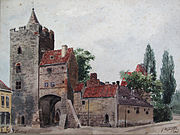Karl Wischke
Karl Wischke (born January 8, 1872 in Müncheberg , Lebus district , † August 25, 1943 in Woltersdorf ) was a German architect , lecturer, painter and draftsman .
Karl Wischke, whose artistic activity can be derived from his professional as an architect, verifiably created a number of watercolors and pen drawings of historical buildings of his time and his home in the Brandenburg region during his studies at the Royal Technical University of Berlin at the beginning of the 20th century. Illustrations of monasteries, city gates and churches are known, but also landscape studies with farms and lakeside shores. In addition to similar motifs, his pen drawings also include templates for decorative leaves for a wide variety of occasions, such as weddings and christenings. His designs for city gates and exclusive villas are also known, as well as a number of designs for special building parts. So far only watercolors, pencil and pen drawings are known.
Life
childhood
Wilhelm Wischke was born in 1872 as the second of six children of the master bricklayer Karl Wischke in Müncheberg in the Mark, district of Lebus (today Märkisch-Oderland). His older brother was Wilhelm Ludwig Friedrich Karl Wischke , who was born on December 21, 1869 in Müncheberg and died in Danzig on August 7, 1928 , and was a senior teacher of drawing at the Conrad High School and the Conrad High School in Langfuhr . Unfortunately, nothing has come down to us about the first attempts at painting and drawing, but it can be assumed that both brothers received a sound training in drawing in the early years of their childhood. If the brother embarked on a pedagogical career (he passed the drawing teacher examination in Berlin on August 8, 1899), Karl Wischke's interest in architecture awoke, which would enable him to continue to demonstrate his talent for drawing. He not only wanted to put mere images of reality on paper, but also to translate the designs he had thought up and recorded into reality.
Education 1900–1904
From 1900 to 1904 Karl Wischke was enrolled as a guest student at the Royal Technical University of Berlin in Department I (= architecture) and left with a certificate of enrollment on July 28, 1905. From this time there are prints of seminar papers from the Königlich Technische Hochschule Berlin in the architecture museum of the Technical University of Berlin, which also contain examples from his hand and which impressively document his drawing skills. These are mostly designs for city gates, villas and sarcophagi or building details, such as B. Stringer strings and various types of consoles.
Professional and artistic career from 1905
So far, little research has been carried out into working after graduation. In the program of the Königlich Technische Hochschule zu Berlin for the academic year 1907–1908, the architect Professor Wischke is listed as a permanent assistant in the department for general sciences, especially for mathematics and natural sciences, with his residence at Tempelherrenstrasse 15 III in Berlin S53.
On June 30, 1906, the "Schönblick-Baugesellschaft-mbH" was formed in Woltersdorf ( Niederbarnim district ), which carried out the construction contracts for the colonists of today's part of Woltersdorf, Schönblick . As an architect, Karl Wischke was the company's first managing director. It can be assumed that many of the resulting buildings in Schönblick, as well as the near and far surroundings, bear Wischke's signature.
Works
Karl Wischke's works can be seen in the architecture museum of the Technical University of Berlin in the collections of prints from seminar papers. A few works ended up in private collections at auctions.
literature
- Haselberger, Max: Woltersdorf (Niederbarnim district). The 700 year history of a Brandenburg village. Adapted from documents and official sources by Max Haselberger, self-published by the editor 1931, p. 102.
Web links
- Designs and projects by Karl Wischke in the holdings of the Architekturmuseum der TU Berlin
- Mourning jewelry for the brother Wilhelm Wischke
- Memorial exhibition in Gdansk in 1929 for his brother Wilhelm Wischke
Individual evidence
| personal data | |
|---|---|
| SURNAME | Wischke, Karl |
| BRIEF DESCRIPTION | German architect, lecturer, painter and draftsman |
| DATE OF BIRTH | January 8, 1872 |
| PLACE OF BIRTH | Müncheberg |
| DATE OF DEATH | August 25, 1943 |
| Place of death | Woltersdorf |



